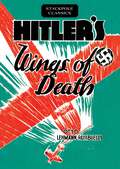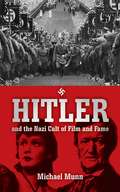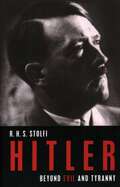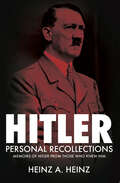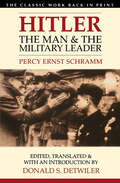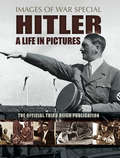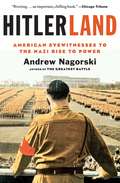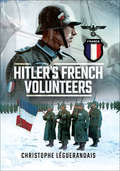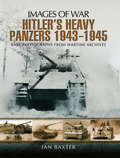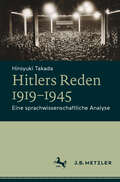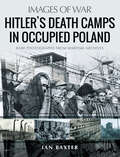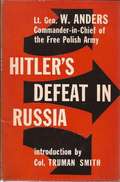- Table View
- List View
Hitler's Wings of Death (Stackpole Classics)
by Otto Lehmann-RussbueldtHow big is Germany&’s Air Force?Of what is it capable?Is Hitler preparing for battle?Will Germany wage and air-war?These questions, and many more, are answered in this book. Concisely, employing a lucid style which will be refreshing to American readers, Herr Lehmann-Russbueldt states the case of Hitler&’s rapidly growing air corps.First-hand information is divulged, unassailable facts are presented, and everyone—students of international affairs or not—will lay down this book with a greater knowledge and a truer realization of the martial situation prevelant in Germany under Der Fuehrer.
Hitler, Donitz, and the Baltic Sea
by David GrierThe popular conception of Hitler in the final years of World War II is that of a deranged Fuhrer stubbornly demanding the defense of every foot of ground on all fronts and ordering hopeless attacks with nonexistent divisions. To imply that Hitler had a rational plan to win the war flies in the face of widely accepted interpretations, but historian Howard D. Grier persuasively argues here that Hitler did possess a strategy to regain the initiative in 1944-45 and that the Baltic theater played the key role in his plan.In examining that strategy, Grier answers lingering questions about the Third Reich's final months and also provides evidence of its emphasis upon naval affairs and of Admiral Karl Donitz's influence in shaping Hitler's grand strategy. Donitz intended to starve Britain into submission and halt the shipment of American troops and supplies to Europe with a fleet of new Type XXI U-boats. But to test the new submarines and train their crews the Nazis needed control of the Baltic Sea and possession of its ports, and to launch their U-boat offensive they needed Norway, the only suitable location that remained after the loss of France in the summer of 1944.This work analyzes German naval strategy from 1944 to 1945 and its role in shaping the war on land in the Baltic. The first six chapters provide an operational history of warfare on the northern sector of the eastern front and give evidence of the navy s demands that the Baltic coast be protected in order to preserve U-boat training areas. The next three chapters look at possible reasons for Hitler's defense of the Baltic coast, concluding that the most likely reason was Hitler's belief in Donitz's ability to turn the tide of war with his new submarines. A final chapter discusses Donitz's personal and ideological relationship with Hitler, his influence in shaping overall strategy, and the reason Hitler selected the admiral as his successor rather than a general or Nazi Party official. With Grier's thorough examination of Hitler's strategic motives and the reasons behind his decision to defend coastal sectors in the Baltic late in the war, readers are offered an important new interpretation of events for their consideration.
Hitler, mi padre
by Antonio González Rivera y RíoCuando el Ejército Rojo está a punto de conquistar Berlín, a finales de la Segunda Guerra Mundial, en el cuartel general de Hitler se Fragua el más arriesgado de los planes: la huida de Hitler y su esposa Eva Braun; pero más aún, de su mayor secreto: le existencia de sus dos hijos. En esta estremecedora novela, un hombre se atreve e contar su historia: la de cómo descubrió que es el hijo del hombre más temido y más odiado del siglo XX.
Hitler: 1889-1936 Hubris
by Ian KershawHailed as the most compelling biography of the German dictator yet written, Ian Kershaw's Hitler brings us closer than ever before to the heart of its subject's immense darkness. From his illegitimate birth in a small Austrian village to his fiery death in a bunker under the Reich chancellery in Berlin, Adolf Hitler left a murky trail, strewn with contradictory tales and overgrown with self-created myths. One truth prevails: the sheer scale of the evils that he unleashed on the world has made him a demonic figure without equal in this century. Ian Kershaw's Hitler brings us closer than ever before to the character of the bizarre misfit in his thirty-year ascent from a Viennese shelter for the indigent to uncontested rule over the German nation that had tried and rejected democracy in the crippling aftermath of World War I. With extraordinary vividness, Kershaw recreates the settings that made Hitler's rise possible: the virulent anti-Semitism of prewar Vienna, the crucible of a war with immense casualties, the toxic nationalism that gripped Bavaria in the 1920s, the undermining of the Weimar Republic by extremists of the Right and the Left, the hysteria that accompanied Hitler's seizure of power in 1933 and then mounted in brutal attacks by his storm troopers on Jews and others condemned as enemies of the Aryan race. In an account drawing on many previously untapped sources, Hitler metamorphoses from an obscure fantasist, a "drummer" sounding an insistent beat of hatred in Munich beer halls, to the instigator of an infamous failed putsch and, ultimately, to the leadership of a ragtag alliance of right-wing parties fused into a movement that enthralled the German people. This volume, the first of two, ends with the promulgation of the infamous Nuremberg laws that pushed German Jews to the outer fringes of society, and with the march of the German army into the Rhineland, Hitler's initial move toward the abyss of war.
Hitler: A Global Biography
by Brendan SimmsFrom a prize-winning historian, the definitive biography of Adolph HitlerHitler offers a deeply learned and radically revisionist biography, arguing that the dictator's main strategic enemy, from the start of his political career in the 1920s, was not communism or the Soviet Union, but capitalism and the United States. Whereas most historians have argued that Hitler underestimated the American threat, Simms shows that Hitler embarked on a preemptive war with the United States precisely because he considered it such a potent adversary. The war against the Jews was driven both by his anxiety about combatting the supposed forces of international plutocracy and by a broader desire to maintain the domestic cohesion he thought necessary for survival on the international scene.A powerfully argued and utterly definitive account of a murderous tyrant we thought we understood, Hitler is essential reading for anyone seeking to understand the origins and outcomes of the Second World War.
Hitler: And the Nazi Cult of Film and Fame
by Michael MunnA shocking look into the twisted, lurid world of Nazi Germany’s film industry. In Nazi Germany, the cult of celebrity was the embodiment of Adolf Hitler’s style of cultural governance. Hitler’s rise to power owed much to the creation of his own celebrity, and the country’s greatest stars, whether they were actors, writers, or musicians, could be one of only two things: If they were compliant, they were lauded and awarded status symbols for the regime; but if they resisted—or were simply Jewish—they were traitors to be interned and murdered. This fascinating analysis offers a shocking portrait of a Hitler shaped by aspirations to Hollywood-style fame, of the correlation between art and ambition, of films used as weapons, and of sexual predilections. The Führer believed he was an artist, not a politician, and in his Germany, politics and culture became one. His celebrity was cultivated and nurtured by Joseph Goebbels, Germany’s supreme head of culture. Hitler and Goebbels enjoyed the company of beautiful female film stars, and Goebbels had his own “casting couch.” In Germany’s version of Hollywood, there were scandals, starlets, secret agents, premieres, and party politics. The Third Reich would launch filmmaker and actress Leni Riefenstahl to prominence by making her its own glorifying documentarian, most famously in The Triumph of the Will, the innovative film starring Hitler and widely considered to be one of the greatest propaganda movies ever made. It is no coincidence that Eva Braun, Hitler’s longtime partner and wife for the two days leading up to their joint suicide, was a photographer, and in fact shot most of the surviving photographs and film footage of her lover. In this “creepy yet compelling who’s-who of collaboration in the big-screen industry during the Nazi era,” film historian Michael Munn “offers a hard-driving study of Hitler’s music and film obsessions and the sacrifice of untold talent and youth to the murderous Nazi ideology” (Kirkus Reviews). Hitler and the Nazi Cult of Film and Fame also reveals previously unpublished information about the “Hitler film,” which Goebbels envisaged as “the greatest story ever told,” although it was ultimately trumped by the dictator’s own, real-life Wagnerian finale.
Hitler: Beyond Evil and Tyranny (German Studies)
by R. H. StolfiThis fascinating and richly detailed new biography of Hitler reinterprets the known facts about the Nazi Fuehrer to construct a convincing, realistic portrait of the man. In place of the hollow shell others have made into an icon of evil, the author sees a complex, nuanced personality. Without in any way glorifying its subject, this unique revision of the historical Hitler brings us closer to understanding a pivotal personality of the twentieth century.
Hitler: Dictator or Puppet?
by Andrew NormanWritten by an authority on Adolf Hitler, this book charts new ground and shows how the writings of a deluded ex-monk, Lanz von Liebenfels and the pseudo-science of Liebenfels and other writers, convinced Hitler that Germanys destiny was to save the world from a Jewish-Bolshevik conspiracy. It was this perverted sense of destiny that drove the Nazi Party and led to the outbreak of WWII and the deaths of some sixty million people as well as the destruction of much of Europe. Using the writings of Liebenfels from his magazine Ostara, Dr Andrew Norman demonstrates how the mass murders of Jews, Gypsies, mentally-ill people and those regarded as less than human had its roots in articles written by Liebenfels. An index of Ostara articles is included and their very titles indicate the malign influences that shaped Hitlers Germany.
Hitler: Memoirs of Hitler From Those Who Knew Him
by Heinz A. HeinzHeinz A. Heinz was the only writer authorised by the Nazi Party to draw a biography of the Fhrer for publication in the English speaking world. The result was the 1938 authorised biography of Adolf Hitler entitled Germany's Hitler.The book was based on interviews supplied first hand by those friends, helpers and comrades who had believed in him from the beginning of his political career. Heinz A. Heinz was a professional journalist and author, he interviewed Hitler's old school friends, army colleagues, landlords, his jailer, and early party comrades including an invaluable interview with Anton Drexler to produce an unprecedented insight into Adolf Hitler as viewed by his acquaintances during the inter-war period.These remarkable interviews were given by those who had stood by him in his darkest days, and who lived to see one of the most astounding political achievements in history. Included are vivid and unique descriptions of Hitler at school, his First World War battlefield experiences, the early political struggles, the full story behind the 9th November Beer Hall Putsch, Hitler in prison, and the struggle to power from 1926 to 1933.Featuring a new introduction by Emmy Award winning writer and historian Bob Carruthers, this book is a vital primary source reference work for anyone interested in understanding how and why Hitler won the total adulation and support of such a large section of the German people.
Hitler: Military Commander
by Rupert MatthewsA comprehensive examination of Hitler’s military strategies.As Führer of the Third Reich, Hitler was responsible for deciding the German war aims in 1939. As head of the Armed Forces from February 4th, 1938, he was also responsible for the overall Wehrmacht strategy intended to achieve these aims. Hitler: Military Commander examines with impeccable detail Hitler's key military decisions during the Second World War, and assesses how far these decisions were militarily justified in the light of the intelligence available at the time. Perhaps most importantly, it tackles the larger questions of how a non-German former corporal, albeit the holder of the Iron Cross First Class, managed to take personal control of an army with the Prussian traditions of the German army; to appoint, sack, and sentence to death its generals at will, to lead it into a World War it was not prepared for; and to ultimately destroy it. Featuring black-and-white photographs, maps, biographical context, tactical analysis, and more, this new edition of Hitler: Military Commander will give readers the comprehensive overview of Hitler's military decisions and downfall.
Hitler: The Man and the Military Leader
by Donald S. Detwiler Percy Ernst SchrammPercy Ernst Schramm, one of Germany's most distinguished historians, had exceptional access to Adolf Hitler because from January 1943 to the end of the war he was the Fuhrer's official war diarist. This classic volume, long out of print, contains the introductions written by Schramm to critical editions of Hitler's Table Talk and the official War Diary of the High Command of the Wehrmacht. In addition, there are two appendices: the first consisting of excerpts from a study composed by Schramm for the Nuremberg Trials on relations between Hitler and the General Staff; the second a memorandum written by General Jodl in 1946 on Hitler's military leadership.
Hitler: The Memoir of the Nazi Insider Who Turned Against the Fuhrer
by Ernst Hanfstaengl John Willard TolandOf American and German parentage, Ernst Hanfstaengl graduated from Harvard and ran the family business in New York for a dozen years before returning to Germany in 1921. By chance he heard a then little-known Adolf Hitler speaking in a Munich beer hall and, mesmerized by his extraordinary oratorical power, was convinced the man would some day come to power. As Hitler's fanatical theories and ideas hardened, however, he surrounded himself with rabid extremists such as Goering, Hess, and Goebbels, and Hanfstaengl became estranged from him. But with the Nazi's major unexpected political triumph in 1930, Hitler became a national figure, and he invited Hanfstaengl to be his foreign press secretary. It is from this unique insider's position that the author provides a vivid, intimate view of Hitler--with his neuroses, repressions, and growing megalomania--over the next several years. In 1937, four years after Hitler came to power, relations between Hanfstaengl and the Nazis had deteriorated to such a degree that he was forced to flee for his life, escaping to Switzerland. Here is a portrait of Hitler as you've rarely seen him.
Hitler: The Official Third Reich Publication (Images of War Special)
by Bob CarruthersThis exceptional source is probably the best of the contemporary accounts of Hitler in power, albeit from a heavily pro-Nazi stance. The testimonies collected together were based on interviews conducted by Heinz A. Heinz in 1933 and 1934, shortly after Hitler had taken power.Millions of ordinary Germans fell under Hitler's spell and this book is a creation of those emotions. It is very much a product of its time. Written by the party big-wigs, such as Goering, Speer and Goebbels, and published in 1935 under the title Adolf Hitler Bilder Aus Dem Leben Des Furhers, it appeared at a time when they were at the height of their unrivaled powers. This fascinating volume encompasses the superb photography of Heinrich Hoffman, the Munich photographer who was ever present on Hitler's journeys and who grew fabulously wealthy as a result of his intimate access to Hitler. Hitler had an innate understanding of what we would now call public relations. He recognised the excellence of Hoffman's photography and maintained control of his image by limiting the access of other photographers. He also strictly controlled Hoffmann's activities and personally selected the portraits that were allowed to go into circulation.The book incorporates sections on Hitler and the German people, Hitler and the German workers, Hitler and public works and so on, all accompanied by a series of excellent photographs which form a remarkable record of the public face of a man during his brief spell of absolute power. The Nazis were the first party who harnessed the full power of the media in a coherent and all-embracing manner.This is a classic example of the strength of their presentation skills. It is a compelling time-capsule which conveys vividly in almost visceral way the zeitgeist of the thirties in Nazi-Germany. By 1935 the bulk of the German people had fallen in behind Adolf Hitler, and with documents as persuasive as this, it is not too difficult to comprehend the allure of the glittering faade which a stream of publications such as this book sought to create and maintain.
Hitlerland: American Eyewitnesses to the Nazi Rise to Power
by Andrew NagorskiHitler's rise to power, Germany's march to the abyss, as seen through the eyes of Americans--diplomats, military, expats, visiting authors, Olympic athletes--who watched horrified and up close. By tapping a rich vein of personal testimonies, Hitlerland offers a gripping narrative full of surprising twists--and a startlingly fresh perspective on this heavily dissected era. Some of the Americans in Weimar and then Hitler's Germany were merely casual observers, others deliberately blind; a few were Nazi apologists. But most slowly began to understand the horror of what was unfolding, even when they found it difficult to grasp the breadth of the catastrophe. Among the journalists, William Shirer, Edgar Mowrer, and Dorothy Thompson were increasingly alarmed. Consul General George Messersmith stood out among the American diplomats because of his passion and courage. Truman Smith, the first American official to meet Hitler, was an astute political observer and a remarkably resourceful military attaché. Historian William Dodd, whom FDR tapped as ambassador in Hitler's Berlin, left disillusioned; his daughter Martha scandalized the embassy with her procession of lovers from her initial infatuation with Nazis she took up with. She ended as a Soviet spy. On the scene were George Kennan, who would become famous as the architect of containment; Richard Helms, who rose to the top of the CIA; Howard K. Smith, who would coanchor the ABC Evening News. The list of prominent visitors included writers Sinclair Lewis and Thomas Wolfe, famed aviator Charles Lindbergh, the great athlete Jesse Owens, newspaper publisher William Randolph Hearst, and black sociologist and historian W.E.B. Dubois. Observing Hitler and his movement up close, the most perceptive of these Americans helped their reluctant countrymen begin to understand the nature of Nazi Germany as it ruthlessly eliminated political opponents, instilled hatred of Jews and anyone deemed a member of an inferior race, and readied its military and its people for a war for global domination. They helped prepare Americans for the years of struggle ahead.
Hitlers French Volunteers
by Christophe LeguérandaisFrom 1941 to 1945, a large number of foreign soldiers were incorporated into the ranks of the German army in order to compensate for the enormous losses suffered by the Wehrmacht, including thousands of French. Whether fighting against the Soviets on the Eastern Front, with the Afrika-Korps in Tunisia or fighting with the occupying army in France, these volunteers generally took the plunge to join the Germans with the authorization of their own government, even though there was never any 'formal link' to the Vichy regime.For the first time in the English language, this book provides details of the units' various insignias, along with rare and previously unpublished and personal photographs of the few surviving members interviewed by the author. As a result, a new vision of these collaborators emerges, allowing them to be regarded as adventurers or even nationalists. After all, despite being clothed in the enemy's uniform, the majority of these soldiers respected their oath of allegiance, often giving their lives in return.
Hitlers Hangmen: The Secret German Plot to Kill Churchill
by Brian LettBefore and after the outbreak of the Second World War there were sizeable Fascist groups active in Britain, working to overthrow the British government. Most of the Fascist leaders were interned in 1940 as soon as Churchill came to power, but were freed in the better times of 1944, all the more embittered and just as intent on installing a Fascist government and taking revenge on Churchill. By late 1944 there were hundreds of thousands of German prisoners of war in Britain, many of them in camps brutally dominated by the SS and other Nazi fanatics. When Hitler tried to restore Germany&’s position with his massive Battle of the Bulge offensive he gave orders for this to be supported by a break-out from all of the POW camps under Nazi control. Some of the escapers were to head for London to assassinate Churchill, with the help of the British Fascists. It was only by chance that the plot was foiled. This is the incredible, disturbing story of how close British Fascists came to impacting the outcome of the Second World War. It is also a comprehensive investigation of the break-out plot as it unfolded across Britain: how it came to fruition and how it was quashed, its repercussions and the many little-known stories of escape and recapture which took place throughout the country.
Hitlers Heavy Panzers, 1943–1945 (Images of War)
by Ian BaxterThis WWII pictorial history offers a fully illustrated and informative look at Nazi Germany&’s fearsome heavy tanks with rare wartime photos. With its authoritative text, detailed captions, and rare images, this volume chronicles the last desperate years of the Wehrmacht Panzerwaffe. Despite a worsening strategic situation both on the Eastern Front and in the West, Hitlers Panzers and their highly motivated crews showed superior tactical abilities and killing power—yet these armored battalions were not enough to alter the course of the war as the Allies closed in on Berlin. This superb book covers many variants to the Heavy Panzer, some well-known and others less so—including modified, up-armored and up-gunned tanks. Copious images of Tigers 1 and 11, Panzerjager, Panthers, Panzer 4s, StuG IV and III, Wespes, Hummels are provided as well as other fine examples of German engineering.
Hitlers Reden 1919–1945: Eine sprachwissenschaftliche Analyse
by Hiroyuki TakadaHitlers Reden spielten eine entscheidende Rolle im Prozess der nationalsozialistischen „Machtergreifung“ und der späteren Durchsetzung ihrer Politik. Das Buch untersucht die Gründe für die enorme Wirkung von Hitlers Auftritten, indem es die 1,7 Millionen Wörter, die die Reden umfassen, systematisch und in ihrer Entwicklung analysiert. Unter Einbeziehung der historischen und technikgeschichtlichen Hintergründe sowie detaillierten Beschreibungen von Hitlers Auftreten, seinen Gesten und rhetorischen Mitteln entsteht so eine Gesamtdarstellung von Hitlers Entwicklung als Redner – von den euphorisierenden Anfängen in den Bierkellern bis zu den kaum mehr beachteten Einlassungen am Ende des Krieges.
Hitler’s Allies: The Ramifications of Nazi Alliance Politics in World War II (Routledge Studies in Second World War History)
by John P. MigliettaThis book examines the significance of alliances in the international system, focusing on the dynamics between great and regional powers, and on the alliances Nazi Germany made during World War II, and their implications for Germany. It examines a variety of case studies and looks at how each of the respective states contributed to or weakened Nazi Germany’s warfighting capabilities. The cases cover the principal Axis members Italy and Japan, secondary Axis allies Hungary and Romania, as well as neutral states that had economic and military significance for Germany, namely Bulgaria, Iran, Spain, Sweden, Switzerland, Turkey, and Vichy France. Additional case studies include topics such as the German attempts to cultivate Arab nationalism, focusing on German involvement in the coup in Iraq against the pro-British government, and the wartime state of Croatia, whose creation was made possible by Germany, with the rivalry between Germany and Italy for control being a major focus. The book also includes a case study exploring the unique position of Finland among German allies as a democracy and how the country was essentially fighting a very different war from Nazi Germany. This will be of interest to students and academics with an interest in power dynamics in World War II, economic, political, strategic, and alliance theory, and scholarly debate on Nazism and Europe.
Hitler’s Death Camps in Occupied Poland: Rare Photographs from Wartime Archives (Images of War)
by Ian BaxterCovers the six principal extermination camps in Nazi occupied Poland; a sobering reminder of the horrors of the Holocaust.Nearly 80 years on, the concept and scale of the Nazis’ genocide program remains an indelible, nay almost unbelievable, stain on the human race. Yet it was a dreadful reality of which, as this graphic book demonstrates, all too much proof exists. Between 1941 and 1945 an estimated three and a half million Jews and an unknown number of others, including Soviet POWs and gypsies, perished in six camps built in Poland; Auschwitz-Birkenau, Belzec, Chelmno, Majdenak, Sobibor and Treblinka. Unpleasant as it may be, it does no harm for present generations to be reminded of man’s inhumanity to man, if only to ensure such atrocities will never be repeated. This book aims to do just this by tracing the history of the so called Final Solution and the building and operation of the Operation Reinhard camps built for the sole purpose of mass murder and genocide.
Hitler’s Defeat In Russia
by Lieutenant-General Władysław AndersTo both professional soldiers and historians, the causes of the German catastrophe in Eastern Europe in the years from 1941 to 1945 will ever remain an absorbing problem. Why did Hitler’s hitherto invincible Wehrmacht—which between September 1939 and June 1941 had knocked over like tenpins the far from negligible armies of Poland, France, and Yugoslavia, had driven three-hundred-odd thousand British from the continent in a campaign of a few brief weeks, and had spread the rule of Hitler’s Reich from Brest to Crete and from Arctic Narvik to the desert sands of Tripoli—why did this Wehrmacht come to a dead halt before Moscow within six months of launching its all-out assault on the Soviet Union? Why, once again in the autumn of 1942, did the Wehrmacht suffer such an overwhelming defeat at Stalingrad—after occupying nearly half of European Russia, reducing the Red armies to less than two and one half million men at the beginning of 1942, and planting the swastika on Mount Elbrus in the Caucasus, more than 1,000 miles from its advanced base in Poland?These are questions General Anders attempts to answer in the present analytical study of the Russo-German war—and, in my opinion, he succeeds to the full, with amazing clarity and unanswerable logic.-Foreword.
Hitler’s Female Physicians: Women Doctors During the Third Reich and Their Crimes Against Humanity
by Edzard ErnstThere have been many books about the doctors of the Third Reich and their atrocities. Most of these books neglect the contribution of women in the medical profession. In this book, they are the focus of attention. The first section of the book explains the background of the Third Reich in general and medicine during this period in particular. It addresses the situation of female doctors and why there were relatively few of them. It goes on to detail the forms of transgression that occurred under Nazi rule—involuntary sterilization, euthanasia, and mass murder of Jews and other groups considered undesirable. The second part of the book is a collection of 38 alphabetically arranged biographies of individual female doctors who participated in these activities. It reports on the actions they took and what happened to them after the war. The final chapter draws some conclusions, which can be briefly summarized as follows: 1) the female doctors' role remains under-researched, 2) generally speaking, female doctors were also guilty, but their transgressions generally less gruesome than those of their male colleagues, 3) many of the deeds of female doctors are nevertheless shocking.
Hitler’s French Literary Afterlives, 1945-2017
by Manuel BragançaThis book analyses the successive appearances of Adolf Hitler in French fiction between 1945 and 2017. It discusses why, unlike what has been observed in the US and in the UK, it has proven problematic for French novelists to write about Hitler in their numerous fictional explorations of the Second World War. It examines the literary and ethical challenges of including historical characters such as Hitler in fiction, and demonstrates how these challenges evolved over time as memories of the Second World War also evolved in France.
Hitler’s Imperfect Victories: Campaigns in Western Europe 1939–1941
by Rex BashfordA comprehensive analysis of Hitler’s role as the supreme military leader of the Third Reich across all the major campaigns. There have been many books on Adolf Hitler and specific military campaigns and battles during the time of the Third Reich. However, there has never been a comprehensive analysis of Hitler’s role as the supreme military leader of the Third Reich across all the major campaigns. He combined every senior position in government and the armed forces until he was at the same time Supreme Commander of the Armed Forces, Chancellor, Minister of War and Commander-in-Chief of the Army. He was involved in every aspect of the German war effort including new weapons development. How well did he perform these roles? He called himself a genius and was described as ”the greatest German military leader of all time” by one of his most senior military leaders – was he? What does the evidence show? This book analyses each of the Third Reich’s military campaigns paying special attention to Hitler’s role in them. The book is based entirely on the evidence of the most senior military personnel who were there at the time, from their contemporaneous diaries and subsequent writings. The sources used include the diaries and recollections of three Chiefs of the Army General Staff, Field-Marshals Rommel, von Rundstedt, von Bock, von Kliest, von Manstein, numerous other senior generals, Hitler’s military adjutants, ministers of his government and evidence from the Trial of the Major War Criminals at Nuremberg. Is there a consistent thread in this evidence? The first Volume is called Imperfect Victories and deals with the Polish, Scandinavian and French campaigns.
Hitler’s Jet Plane: The ME 262 Story
by Mano ZieglerThe first operational military jet in the world, towards the end of the Second World War the ME 262 was to be the German miracle weapon. Mano Ziegler was involved from its inception and contributed to the design, testing, and training and even served in it operationally. Could the ME 262 have broken the Allied supremacy in the air? Why did it take so long to come into service and why were hundreds of German pilots sacrificed in developing it? Why did the ME 262 prove not to be the unparalleled success claimed by Goering and why were German cities left dangerously exposed against Allied bombing campaigns? These are only some the important questions this new book answers.Mano Ziegler, born 7 June 1908, had a lifetime fascination with flight. At the age of eight, he wrote to Manfred Freiherr von Richthofen, the famous Red Baron, asking to be allowed to fly with him. Richthofen even replied, telling him, Yes, we'll fly together! When war broke out in 1939 he became a pilot in the Luftwaffe, and from 1943 until the war's end, he flew the Me 163.
